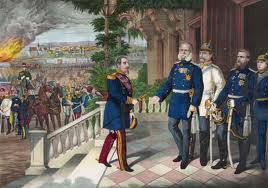THE FRANCO-GERMAN MONETARY POLICY WAR

At the nub of the euro crisis is the mandate given to the European Central Bank (ECB). Declared independent of any government authority, it has steadfastly stuck to its remit of controlling inflation, with a tolerance threshold set at 2 %. The instrument that the ECB uses to keep inflation under control is its key interest rate, changes to which impact the structure of interest rates across the economy.
Of course, the ECB also reacts to economic activity levels in the euro zone. Yet these are secondary to inflation control. A good example was the ECB’s astonishing decision to hike its key interest rate twice in the spring of 2011 just when Europe was collapsing under the weight of recession and the public debt crisis.
Why is the ECB so constrained by inflation control when the evidence would advocate monetary easing as in the United States and Japan?
The explanation is the no doubt justified fear that Germany had of seeing its deutsche mark suffering a series of devaluations after its transformation into the euro. The Germans demanded that the ECB be politically independent to prevent the institution from turning into a discount window for public debt. In reality, the ECB should have steadily increased money supply as an offset to budget and trade deficits in the weakest euro zone partners. When a currency is no longer tied to gold, tight discipline is required for new money creation, as confidence alone underpins purchasing power. While this political choice was understandable in 1999, it no longer is so in 2013.
In fact, something else lies behind the Germany’s political request: for Germany, public debt should be financed by savings, whose purchasing power must at all costs be maintained. Since the Weimar inflation (1923) and the confiscation of their assets when the reichsmark was replaced by the deutsche mark in 1948, Germans have insisted on a strong currency that encourages disinflation and instills discipline.
Printing money to repay public debt is out of the question on the other side of the Rhine. By contrast, the United States consider that public debt can be financed by creating new money, as this has an operational impact. For Americans, a currency’s value is less important than job creation. In a nutshell, German money goes into savings, whereas the dollar fuels consumption.
More profoundly, all German social thinking is rooted in a fear of inflation that stems from Protestantism’s attribution of a temporal dimension to money. This theological backdrop could explain why debt is, in German eyes, unhealthy (in German "debt" and "fault" are the same word). Capitalism reputedly emerged in the XVIth century in communities of the Protestant faith. The austere spirit of Lutheranism is thought to have brought the modern market economy into being. Protestants do not consume their wealth. They borrow even less. Unlike Catholicism, which is based on repentance, reformist religion, in part, springs from the notion of predestination. It involves a demonstration of proof somewhere in the future. The aim is to prove by our toil that we deserve the destiny that God has reserved for us. In this sense, Protestant-style materialistic success is simply the manifestation of divine will.
This is far removed from Catholicism, which has kept money subordinated to spiritual values. Monetary depreciation was thus acceptable. A distant strand of Catholic thinking ranks money beneath the power of authority and encourages a sense of guilt, even intolerance, towards personal wealth. Consequently, German money is revalued while money in Catholic Southern Europe depreciates or is devalued. In Germany, money is constitutive whereas in France it is an instrument of power. Devalued money is a symptom of money’s subordination to the exercise of authority.
The monetary dispute between the euro’s two main partners, namely France, the handmaid of the Catholic Church, and Germany, home of Martin Luther, has brought these religious contexts to the fore again. By way of illustration, the Deutsche Mark was revalued against the French franc by more than 100 % between 1971 (end of the Bretton Woods agreements) and 1999 (year of the euro’s creation).
Of course, religious factors alone do not fully explain the divergences between Germany and France. Military history has also thrown up monetary confrontations. France has always begrudged Germany the excessive reparations it paid after its defeat in 1870. At the same time, it never obtained fair compensation for the 1914-18, or, even less so, for the 1940-45 wars. Germany for its part blames France for having driven the country to its ruin by the hyperinflation of 1923 and default of 1933 resulting from the 1919 Treaty of Versailles. The question even goes beyond money: monetary negotiations were responsible for defining French and German territorial borders. In 1870, Bismarck signed the constitutive document of the German Empire in Versailles at the price of enormous war reparations. European support for German reunification in 1980 was negotiated in exchange for Germany joining the euro. It is no coincidence that the first two attempts at monetary union with fixed exchange rates (Latin Monetary Union of 1865 and Gold Bloc of 1933) excluded Germany.
Henceforth, the single currency represents a forced rapprochement of two antagonistic monetary cultures. The euro survives because France and Germany gain a temporary advantage from it: Germany has boosted its internal market while France has enjoyed German borrowing rates for its public debt. In Germany, the euro has benefited the private sector whereas in France it has helped to reinforce the role of the state at reduced cost. Can this situation last forever? Nothing is less certain. A better alignment of the two countries’ economies and mutual understanding are the foundations for restoring monetary and fiscal health. Without this rapprochement, the single currency will only serve to lay bare age-old dissensions. As never before, the continued existence of the euro depends on the fragile harmony of the Franco-German axis.
